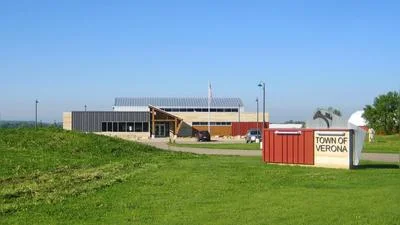Jennifer Mnookin Chancellor | Official website
Jennifer Mnookin Chancellor | Official website
Aquatic invasive species are more widespread in Wisconsin than previously thought
September 5, 2024
By Adam Hinterthuer and Madelyn Anderson
Watermilfoil and algae float near the water’s surface where Dorn Creek Marsh flows into the northern edge of Lake Mendota during summer on July 29, 2015. The aquatic plants and the lake’s ecosystem health are frequently studied as part of ongoing research conducted by the Center for Limnology at the University of Wisconsin–Madison. Photo: Jeff Miller
A report on more than 40 years of research on Wisconsin lakes highlights some lessons scientists have learned about aquatic invasive species, including that far more ecosystems host non-native species than previously thought.
However, researchers note that those species aren’t necessarily detrimental to their new habitat and, in some cases, the negative “impacts of invasive species control may be greater than the impacts of the invasive species” themselves.
That doesn’t mean scientists aren’t concerned about different species moving into new ecosystems, says Jake Vander Zanden, director of the University of Wisconsin–Madison’s Center for Limnology and lead author on the report.
“There are many examples where an invasive species has remarkable ecosystem impacts. They can result in fisheries decline, water quality decrease and more, which negatively impacts humans and the environment,” Vander Zanden says.
But ecological destruction is far from a foregone conclusion in invasive species stories.
The researchers recently published their analysis in the journal BioScience. They highlight several lessons learned through four decades of data collection, research, and experiments conducted by the North Temperate Lakes Long-Term Ecological Research program. Housed at the Center for Limnology, this program is one of 27 such sites funded by the National Science Foundation.
Research grants typically fund a few years of work, Vander Zanden explains. “But that would never allow you to detect these types of changes. It’s only through long-term research that we can get insights into these big questions like where invasive species are, how they are changing our ecosystems and how it all connects to things like climate change.”
One such insight is that non-native aquatic species in Wisconsin lakes are more widespread than initially thought.
The long-term research program has informed Wisconsin Department of Natural Resources maps and datasets on six target species since the 1990s: Eurasian watermilfoil, zebra mussels, spiny water fleas, rusty crayfish, Chinese mystery snail and banded mystery snail.
Combining long-term monitoring records on its 11 core study lakes with field-based research and community-based science on dozens of other water bodies revealed that existing estimates of about 8% of Wisconsin lakes containing one or more of these six species were significantly off. The number is closer to 39%.
Additionally, certain invasive populations have been in waters much longer than initially thought. For example, researchers detected spiny water fleas in Lake Mendota in 2009. However, scientists combing through sediment cores and old samples discovered that this disruptive invasive species had been present in the lake at least a decade sooner but only erupted due to favorable climate changes that summer. These findings suggest that invasive species often exist in an ecosystem without triggering negative impacts.
Moreover, when invasive species do result in negative impacts, those impacts are often tied to existing problems according to Jake Walsh, a co-author of the new paper and postdoctoral associate at the University of Minnesota’s Department of Fisheries, Wildlife, and Conservation Biology.
“Lake Mendota was especially primed for large costly effects from spiny water fleas,” says Walsh. “They worsened water quality problems already present due to excess nutrients in the lake.”
Seeing this fuller picture was only possible through long-term research Walsh adds. “As long as we have this long-range program invasions are experiments that can teach us about how ecosystems work and how we can best manage them,” he says. This has given us a deep understanding of Lake Mendota's water quality issues and a ‘road map’ to follow for offsetting spiny water fleas’ impact.”
Long-term science doesn’t just help scientists piece together environmental change history Vander Zanden adds. With it researchers can also highlight looming questions and design studies to answer them. From using environmental DNA to exploring long-term invasive species removal benefits more discoveries are on the horizon.
And it’s not just science benefiting from this long-term interdisciplinary approach. Undergraduate field technicians who spent their summers sampling sites repeatedly have become professors overseeing their own research projects managing their own students Data scientists staff dedicate huge chunks making datasets publicly available accessible other researchers freshwater sciences
It’s a spirit collaboration exploration Vander Zanden hopes extend fields
“I wonder if some patterns we see from long-term data could be relevant somebody who studies soil grassland flowers marine biology” he says “If invasive species already there more widespread than think human activity climate change could soon trigger population shifts”






 Alerts Sign-up
Alerts Sign-up